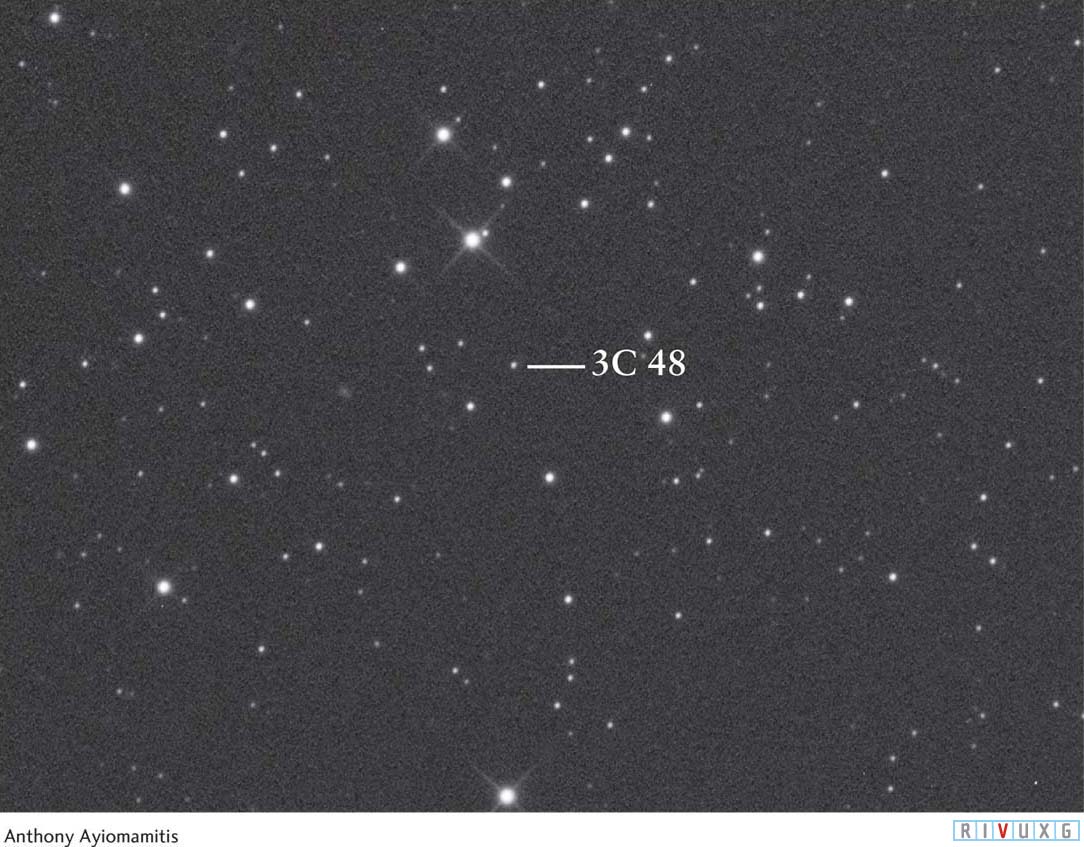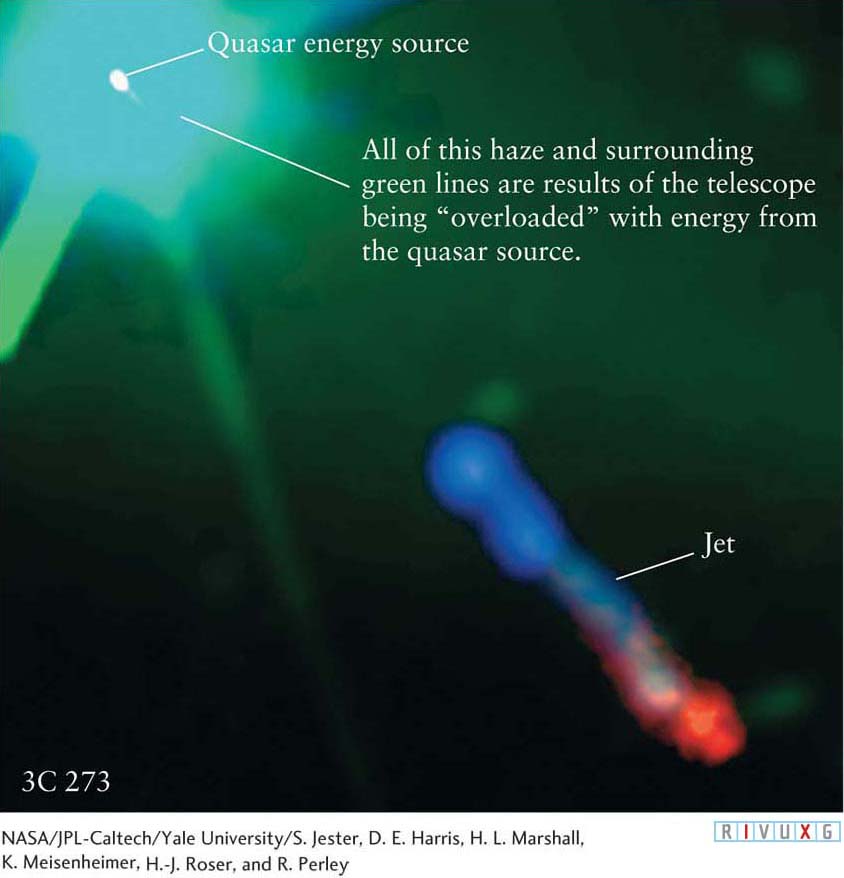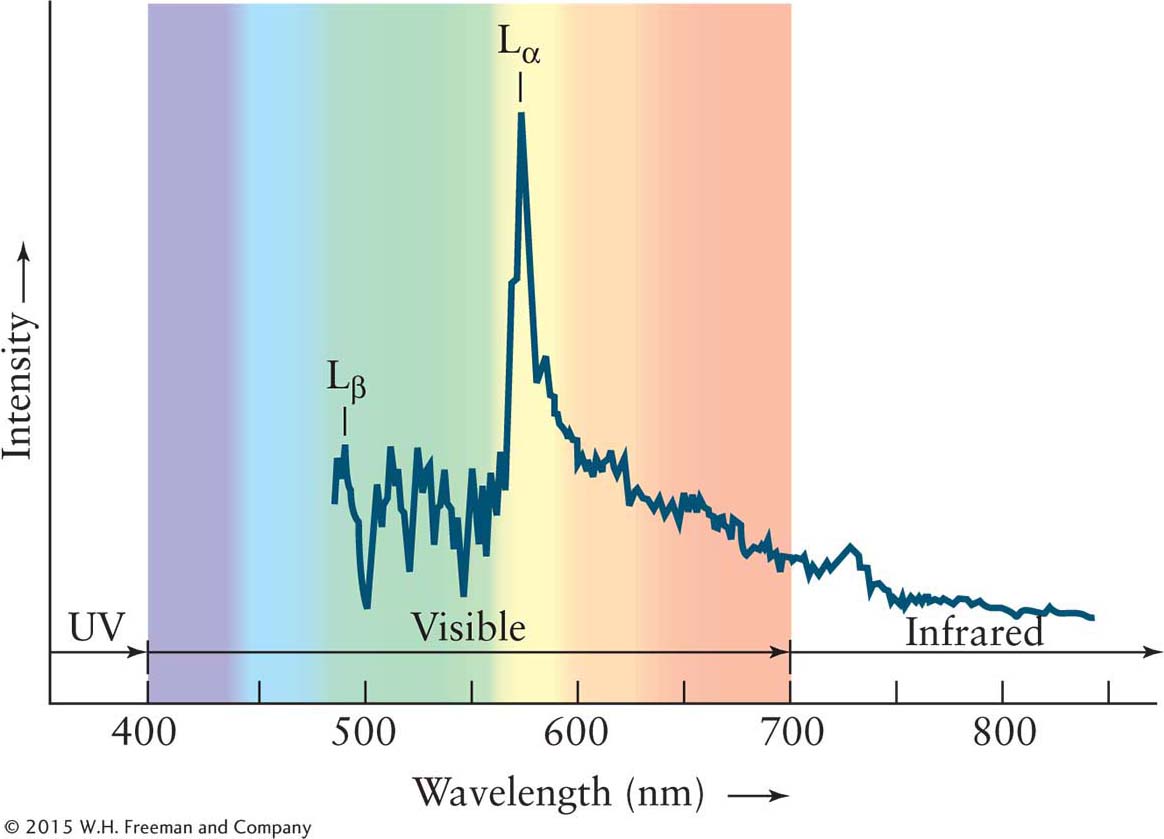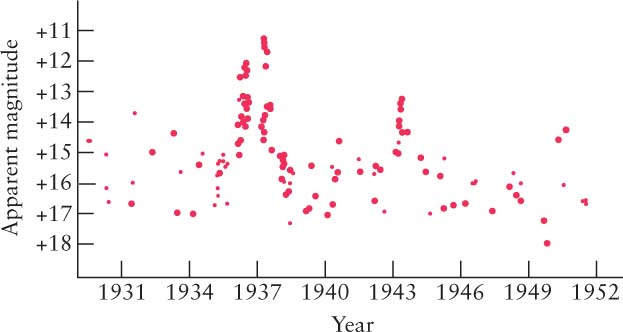QUASARS
Our knowledge of quasars began in an amateur astronomer’s backyard. Grote Reber built the first dedicated radio telescope in 1937 behind his home in Illinois, opening the realm of nonvisual astronomy. (Recall from Section 3-11 that in 1931 Karl Jansky discovered radio waves from sources in space using an antenna originally designed for testing radio communication.) By 1944, Reber had detected strong radio emissions from sources in the constellations Sagittarius, Cassiopeia, and Cygnus. Two of these sources, Sagittarius A (Sgr A) and Cassiopeia A (Cas A), are in our Galaxy. The first is the galactic nucleus (see Section 13-4), and the second is a supernova remnant (see Chapter 12). However, Reber’s third source, called Cygnus A (Cyg A), proved hard to categorize (Figure 13-53). Others quickly refined Reber’s observations, but the mystery only deepened in 1954, when Walter Baade and Rudolph Minkowski, using the 200-in. optical telescope on Mount Palomar, discovered a strange-looking galaxy at the position of Cygnus A (Figure 13-53 inset).

Figure 13-53 

 Cygnus A (3C 405) (a) Radio image produced from observations made at the Very Large Array. Most of the radio emissions from Cygnus A come from the radio lobes located on either side of the peculiar galaxy seen in the inset, a Hubble Space Telescope image. Each of the two radio lobes extend about 160,000 ly from the optical galaxy and contain a brilliant, condensed region of radio emission. Inset: At the heart of this system of gas lies a strange-looking galaxy that has a redshift that corresponds to a recessional speed of 5% of the speed of light. According to the Hubble law, Cygnus A is therefore 635 million ly from Earth. Because Cygnus A is one of the brightest radio sources in the sky, this remote galaxy’s energy output must be enormous. (b) An X-ray image of Cygnus A taken by the Chandra X-ray Observatory showing that some of the jet particles from the central source have spread throughout the galaxy and, striking other gas and dust, caused this debris to heat and emit X-rays.
Cygnus A (3C 405) (a) Radio image produced from observations made at the Very Large Array. Most of the radio emissions from Cygnus A come from the radio lobes located on either side of the peculiar galaxy seen in the inset, a Hubble Space Telescope image. Each of the two radio lobes extend about 160,000 ly from the optical galaxy and contain a brilliant, condensed region of radio emission. Inset: At the heart of this system of gas lies a strange-looking galaxy that has a redshift that corresponds to a recessional speed of 5% of the speed of light. According to the Hubble law, Cygnus A is therefore 635 million ly from Earth. Because Cygnus A is one of the brightest radio sources in the sky, this remote galaxy’s energy output must be enormous. (b) An X-ray image of Cygnus A taken by the Chandra X-ray Observatory showing that some of the jet particles from the central source have spread throughout the galaxy and, striking other gas and dust, caused this debris to heat and emit X-rays.
The galaxy associated with Cyg A is very dim. Nevertheless, Baade and Minkowski managed to photograph its spectrum. They detected a redshift that corresponds to a speed of 14,000 km/s. According to the Hubble law, this speed indicates that Cyg A lies 635 million ly (194 Mpc) from Earth.
Because Cyg A is one of the brightest radio sources in the sky, its enormous distance intrigued astronomers. Although barely visible through the giant optical telescope at Palomar, Cyg A’s radio waves can be picked up by amateur astronomers with backyard equipment. Its radio energy output must therefore be colossal. In fact, Cyg A shines with a radio luminosity 107 times as bright as the radio emission from an entire ordinary galaxy, such as Andromeda. The object that creates the Cyg A radio emissions has to be something extraordinary.
13-19 Quasars look like stars but have huge redshifts
Cygnus A is not the only powerful radio source in the far-distant sky. Starting in the 1950s, radio astronomers created long lists of radio sources. One of the most famous lists, the Third Cambridge Catalogue, was published in 1959. (The first two catalogues were filled with inaccuracies.) Even today, astronomers often refer to its 471 radio sources by their “3C numbers.” Cyg A, for example, is designated 3C 405, because it is the 405th source in the Cambridge list. Because of the extraordinary luminosity of Cyg A, astronomers were eager to learn whether any other sources in the 3C catalog had similar properties.

Figure 13-54  Quasar 3C 48 For several years, astronomers erroneously believed that this object was simply a peculiar, nearby star that happened to emit radio waves. Actually, the redshift of this starlike object is so great that, according to the Hubble law, it must be roughly 4 Bly away.
Quasar 3C 48 For several years, astronomers erroneously believed that this object was simply a peculiar, nearby star that happened to emit radio waves. Actually, the redshift of this starlike object is so great that, according to the Hubble law, it must be roughly 4 Bly away.
One interesting case was 3C 48. In 1960, Allan Sandage used the Palomar telescope to discover a “star” at the location of this radio source (Figure 13-54). Recall that stars are blackbodies whose peak intensity is typically visible light and whose radio emission is much less intense. Because ordinary stars are not strong sources of radio emission, 3C 48 had to be something unusual. Indeed, its spectrum showed a series of emission lines that, initially, no one could identify. Although 3C 48 was clearly an oddball, many astronomers thought it was just another strange star in our Galaxy.

Figure 13-55  Quasar 3C 273 This combined X-ray and infrared view shows the starlike object associated with the radio source 3C 273 and the luminous jet it has created. The jet is also visible in the radio and visible parts of the spectrum. By 1963, astronomers determined that the redshift of this quasar is so great that, according to the Hubble law, it is nearly 2 Bly from Earth.
Quasar 3C 273 This combined X-ray and infrared view shows the starlike object associated with the radio source 3C 273 and the luminous jet it has created. The jet is also visible in the radio and visible parts of the spectrum. By 1963, astronomers determined that the redshift of this quasar is so great that, according to the Hubble law, it is nearly 2 Bly from Earth.

Figure 13-56 Spectra of 3C 273 The visible and infrared spectra of 3C 273 are dominated by four bright emission lines caused by hydrogen. This radiation is redshifted nearly 16% from its rest wavelengths.
Another such “star,” called 3C 273, was discovered in 1962. Like 3C 48, this object (Figure 13-55) emits a series of bright spectral emission lines that no one could then identify. These spectral lines are brighter than the background radiation at other wavelengths, called the continuum (recall Kirchhoff’s laws in Section 3-14). Figure 13-56 shows the spectrum of 3C 273, which looks nothing like a star’s blackbody spectrum with absorption lines. Recall from Chapter 3 that a spectrograph records energy intensity at different wavelengths. The emission lines appear as peaks, and absorption lines appear as valleys. The emission lines are caused by excited gas atoms that emit radiation at specific wavelengths.
A breakthrough finally came in 1963, when Maarten Schmidt at the California Institute of Technology identified four of the brightest spectral lines of 3C 273 as four spectral lines of hydrogen. However, these emission lines from 3C 273 are found at much longer wavelengths than the usual wavelengths of these lines. Schmidt concluded that the hydrogen lines are subjected to a substantial redshift (Doppler shift). Furthermore, the intense emission lines mean that something unusual is heating the gas.
Spectra for stars in our Galaxy exhibit comparatively small Doppler shifts, because these stars cannot move extremely fast relative to the Sun without soon escaping from the Galaxy. Schmidt thus concluded that 3C 273 is not a nearby star after all. Pursuing this conclusion, he promptly found that its redshift corresponds to a speed away from us of almost 16% the speed of light. According to the Hubble law, this huge redshift implies an impressive distance to 3C 273 of roughly 2 billion light-years (Bly).
Inspired by Schmidt’s success, astronomers looked again at the spectral lines of 3C 48. Sure enough, the emission lines were created by hydrogen, but with a redshift that corresponds to a velocity away from us of nearly one-third the speed of light. Therefore, 3C 48 must be nearly twice as far away as 3C 273, or about 4 Bly from Earth, assuming that the Hubble constant, H0, is 69 km/s/Mpc.

Figure 13-57 Spectrum of a High-Redshift Quasar The light from this quasar, known as PKS 2000-330, is so highly redshifted that spectral emission lines normally found in the far-ultraviolet (Lα and Lβ) are seen at visible wavelengths. Note the many deep absorption lines on the short-wavelength side of Lα. These lines, collectively called the Lyman-alpha forest, are believed to be created by remote clouds of gas along our line of sight to the quasar. Hydrogen in these clouds absorbs photons from the quasar at wavelengths less redshifted than the quasar’s Lα emission line.
Focus Question 13-17
How are the spectra of quasars different from the spectra of stars?
Figure 13-57 shows the spectrum of another object that is so far away that the expansion of the universe (see Section 13-17) gives it a redshift of 92% of the speed of light.

 Because of their starlike appearances and strong radio emissions, 3C 48 and 3C 273 were dubbed quasi-stellar radio sources, a term soon shortened to quasars. Related objects, called quasi-stellar objects (QSOs), also look like stars but have strong energy outputs in all different parts of the electromagnetic spectrum, with most being strongest in the infrared. More than 200,000 quasars and QSOs have been discovered. In this book, we will use the word quasars to cover QSOs, too.
Because of their starlike appearances and strong radio emissions, 3C 48 and 3C 273 were dubbed quasi-stellar radio sources, a term soon shortened to quasars. Related objects, called quasi-stellar objects (QSOs), also look like stars but have strong energy outputs in all different parts of the electromagnetic spectrum, with most being strongest in the infrared. More than 200,000 quasars and QSOs have been discovered. In this book, we will use the word quasars to cover QSOs, too.
All quasars have redshifts of at least 0.06, or 6%, of the speed of light. The closest known quasar, Cygnus A, is about 635 Mly from us. The most distant one observed to date has a redshift of 7.1, placing it 12.9 Bly away. It is moving away from Earth at greater than 99% of the speed of light. From the Hubble law, it follows that the distances to these high-redshift quasars are typically in the range of 10 Bly to more than 13 Bly. Plotting their distances, astronomers found that quasars began forming early in the life of the universe (Figure 13-58), their number peaking about 2 billion years after it came into existence. The number of quasars dropped to near zero about 7 billion years ago. The reason for this evolution will become clear shortly.
A quasar emits a huge amount of energy from a small volumeGalaxies are big and bright. A typical large galaxy, like our own Milky Way, contains hundreds of billions of stars and shines with the luminosity of 10 billion Suns. The largest and most luminous galaxies, the giant ellipticals, are only 10 times brighter. But beyond 8 Bly from Earth, even the brightest galaxies are too faint to be easily detected. Most ordinary galaxies are too dim to be detected at half that distance. If quasars can easily be seen more than 13 Bly away, they must be far more luminous than normal galaxies. Indeed, a typical quasar is 100 times brighter than our Milky Way.

Figure 13-58 History of Quasar Formation The greater the redshift of a quasar, the farther it is from Earth and the further back in time we are seeing it. By observing the number of quasars found at different redshifts, astronomers can calculate how the density of quasars has changed over time.

Figure 13-59 Brightness of 3C 279 This graph shows variations in the brightness of the quasar 3C 279. Note the especially large outburst observed in 1937. These data were obtained by carefully examining old photographic plates in the files of the Harvard College Observatory.
In the mid-1960s, several astronomers discovered that quasars fluctuate in brightness. Going back over old images, they found that some newly identified quasars had actually been photographed in the past but had not been considered as anything special because they looked like stars. One photograph of 3C 273, for example, dates back to 1887. By carefully examining these old images, as well as recent ones, astronomers could see that quasars occasionally flare up. Prominent outbursts from quasar 3C 279 reached Earth around 1937 and 1943 (Figure 13-59). During these events, the luminosity of 3C 279 increased by a factor of about 25. At peak periods it was emitting at least 10,000 times as much energy as the entire Milky Way.
Fluctuations and their timescalesSuppose that somewhere on a star or other spherical object an event occurred that began making the object more luminous and then returned it to normal brightness with a total variation or cycle time of, for example, 1 minute. If that fluctuation in luminosity were traveling at the speed of light, then it would take half a minute to cross the object and complete the process of brightening it, and another half a minute to reverse, so that the object would return to its original brightness 1 minute after the event began. If the same fluctuation traveled more slowly, then the object would have to be smaller than half a light-minute across for it to return to its original state after 1 minute. Therefore, the object could not be more than half a light-minute across (ignoring the curve of a sphere). In this way, astronomers can calculate the maximum size an object can have from the timescale of its fluctuation.
Focus Question 13-18
Which can fluctuate faster—an object 1 million km in diameter or an object 1 billion km in diameter?
Many quasars vary in brightness over only a few months, weeks, or days. In fact, X-ray observations reveal large variations in as little as 3 hours. This rapid flickering means that the source of the quasar’s energy must be quite small by galactic standards. The energy-emitting region of a typical quasar—the “powerhouse” that blazes with the luminosity of 100 galaxies—is less than 1 light-day in diameter. Something must be producing the luminosity of 100 normal galaxies from a volume with approximately the same diameter as our solar system! Before considering their energy source, let us examine other objects that will turn out to be powered by the same “engine,” as it is called by astronomers.






 Because of their starlike appearances and strong radio emissions, 3C 48 and 3C 273 were dubbed quasi-
Because of their starlike appearances and strong radio emissions, 3C 48 and 3C 273 were dubbed quasi-



 Cygnus A (3C 405) (a) Radio image produced from observations made at the Very Large Array. Most of the radio emissions from Cygnus A come from the radio lobes located on either side of the peculiar galaxy seen in the inset, a Hubble Space Telescope image. Each of the two radio lobes extend about 160,000 ly from the optical galaxy and contain a brilliant, condensed region of radio emission. Inset: At the heart of this system of gas lies a strang
Cygnus A (3C 405) (a) Radio image produced from observations made at the Very Large Array. Most of the radio emissions from Cygnus A come from the radio lobes located on either side of the peculiar galaxy seen in the inset, a Hubble Space Telescope image. Each of the two radio lobes extend about 160,000 ly from the optical galaxy and contain a brilliant, condensed region of radio emission. Inset: At the heart of this system of gas lies a strang Quasar 3C 273 This combined
Quasar 3C 273 This combined